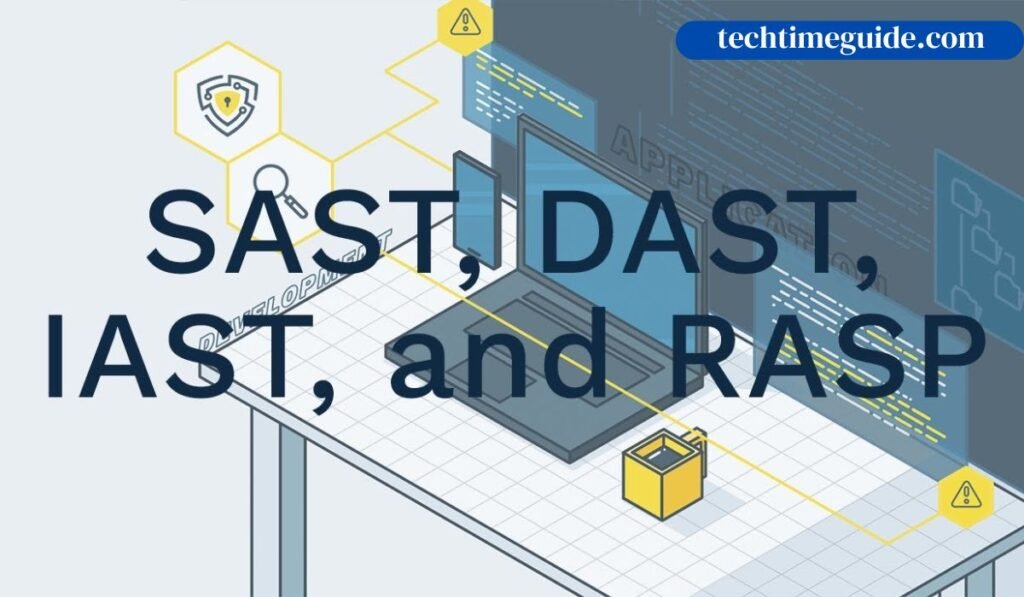Introduction
In today’s rapidly evolving digital landscape, securing applications is no longer optional; it’s a necessity. With software vulnerabilities continuing to be exploited, developers and organizations alike need to adopt robust security testing practices. But with so many security testing methodologies available, like Demystifying SAST, DAST, IAST, and RASP, it can be confusing to understand which one fits best for your project.
Let’s dive into each of these approaches and break down what they are, how they work, and when you should use them to safeguard your applications.
What is SAST? (Static Application Security Testing)
SAST is a testing method that analyzes an application’s source code, bytecode, or binary code for vulnerabilities without executing the application. Essentially, it’s a white-box testing technique that examines the code structure to detect flaws early in the development cycle.
How SAST Works
SAST tools scan the code while it’s being written or before deployment, providing developers with insights into security issues like SQL injections, cross-site scripting (XSS), and buffer overflows. By highlighting vulnerabilities at the code level, SAST helps to “shift left” security in the development lifecycle.
Benefits of SAST
- Early detection: Identifies issues before the software is even compiled.
- Cost-effective fixes: The earlier vulnerabilities are found, the cheaper they are to fix.
- Broad language support: SAST tools usually support a wide variety of programming languages.
Limitations of SAST
- False positives: SAST can sometimes flag issues that aren’t actually threats.
- Cannot detect runtime issues: Because it doesn’t execute the code, runtime vulnerabilities are missed.
What is DAST? (Dynamic Application Security Testing)
Unlike SAST, DAST is a black-box testing approach that involves analyzing the application in its running state. Instead of reviewing the code, DAST simulates attacks on the application from the outside, just as a hacker would.
How DAST Works
DAST tools perform automated scans to probe the running application for security weaknesses, such as misconfigurations, authentication issues, and vulnerabilities that emerge when the app interacts with different systems.
Advantages of DAST
- Real-world testing: DAST reveals vulnerabilities that only show up when the application is running.
- Platform-agnostic: It can test web applications regardless of the underlying language or framework.
Drawbacks of DAST
- Late-stage detection: Issues are found after the app is built, which can make fixing them more costly.
- Limited visibility into code: DAST cannot tell you where in the code the vulnerability exists, only that it’s present.
What is IAST? (Interactive Application Security Testing)
IAST combines the strengths of both SAST and DAST by running in real-time while the application is executing. It provides interactive, in-depth security analysis by analyzing code and behavior simultaneously.
How IAST Works
IAST tools work by embedding agents into the application. These agents monitor the application’s operations and report on vulnerabilities based on how the code interacts with other components, user inputs, and its environment.
Benefits of IAST
- Comprehensive coverage: Detects both code-level issues and runtime vulnerabilities.
- Less false positives: Because it monitors real execution, IAST reduces the number of irrelevant issues flagged.
Challenges in Using IAST
- Overhead: IAST may add overhead to the application, potentially affecting performance.
- Complex setup: Requires tight integration into the application, which may demand additional effort.
What is RASP? (Runtime Application Self-Protection)
RASP is an innovative approach that allows applications to defend themselves during runtime. RASP monitors the application for suspicious behavior and can block attacks in real time without human intervention.
How RASP Works
RASP tools sit within the application or its runtime environment, automatically detecting and responding to threats as they happen. This includes blocking malicious inputs, halting suspicious user sessions, or neutralizing vulnerabilities that are exploited.
Key Advantages of RASP
- Real-time protection: RASP mitigates attacks as they occur, providing immediate defense.
- Customizable responses: Developers can configure RASP tools to respond to threats based on the specific context of the application.
Limitations of RASP
- Performance impact: RASP can slow down an application since it constantly monitors activity.
- Limited detection of sophisticated threats: Some highly sophisticated or zero-day attacks may evade RASP’s detection mechanisms.
Comparing SAST, DAST, IAST, and RASP
Each of these techniques serves a unique purpose, and they’re often most effective when used together. Here’s a quick comparison:
- SAST: Best for early-stage detection during development.
- DAST: Focuses on identifying runtime vulnerabilities.
- IAST: Provides hybrid insights by integrating the best of SAST and DAST.
- RASP: Offers real-time protection during application runtime.
How SAST, DAST, IAST, and RASP Fit Into DevSecOps
As organizations shift toward DevSecOps, integrating security testing into CI/CD pipelines becomes crucial. Each method can be automated:
- SAST tools can be integrated into code review and commit processes.
- DAST can be run automatically during staging or pre-production.
- IAST offers continuous feedback during integration testing.
- RASP remains vigilant post-deployment, securing the live application.
Why Security Testing is Vital for Modern Applications
With threats like SQL Injection, Cross-Site Scripting, and buffer overflows still rampant, security testing must be baked into the development process. SAST, DAST, IAST, and RASP each play a role in reducing vulnerabilities and ensuring that applications remain secure in the face of increasingly sophisticated attacks.
How to Choose the Right Security Testing Approach for Your Project

When choosing between SAST, DAST, IAST, and RASP, consider:
- Stage of development: SAST is best early, while DAST fits later stages.
- Resources available: Some methods may require more computational power or setup time.
- Security needs: Applications requiring continuous protection should lean on RASP, while those in heavy development phases may benefit from SAST.
Best Practices for Implementing SAST, DAST, IAST, and RASP
- Shift left: Implement security testing early in the SDLC.
- Automate: Set up automated tests to run frequently.
- Monitor continuously: Use RASP for real-time protection in production environments.
Real-World Examples of SAST, DAST, IAST, and RASP Tools
- SAST: Veracode, Checkmarx
- DAST: OWASP ZAP, Burp Suite
- IAST: Contrast Security, Seeker
- RASP: Signal Sciences, Imperva
The Future of Application Security Testing
With AI and machine learning, we’re likely to see more adaptive and predictive security tools that evolve alongside threats, making the combination of Demystifying SAST, DAST, IAST, and RASP even more indispensable.
Common Misconceptions About SAST, DAST, IAST, and RASP
Some believe that one tool can replace the other or that implementing them is too costly. However, using them together maximizes security and can be more cost-effective than dealing with breaches post-deployment.
Conclusion
Application security is a critical concern, and understanding the different tools at your disposal is key. Demystifying SAST, DAST, IAST, and RASP each bring unique strengths to the table, and when used in tandem, they create a formidable defense strategy that protects applications from code to runtime.
FAQs
What’s the difference between SAST and DAST?
SAST analyzes source code before the application is run, while DAST tests the running application for vulnerabilities.
Can I use RASP without implementing IAST?
Yes, RASP can be used independently to protect the app during runtime, though combining it with IAST enhances coverage.
Is IAST better than SAST and DAST?
IAST combines the strengths of both SAST and DAST, but it may not completely replace them. It’s often used to complement these techniques.
What is the cost of implementing these security solutions?
The cost varies based on the tool and the size of the project. Open-source options exist, but enterprise-grade solutions typically offer more features.
How can I automate Demystifying SAST, DAST, IAST, and RASP in my workflow?
Use CI/CD tools to trigger these tests at key stages of the development pipeline to ensure continuous security testing.
Also Read More:
How to Resolve Deleted Cluster Node Still Showing in Proxmox


